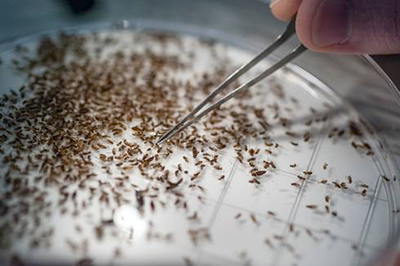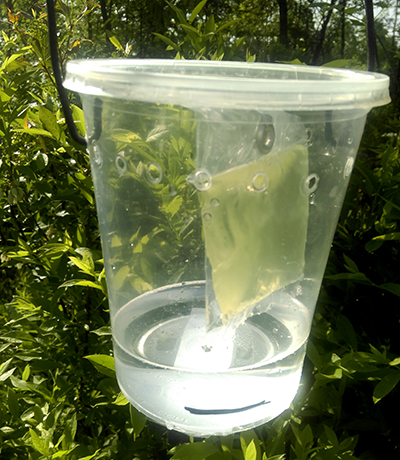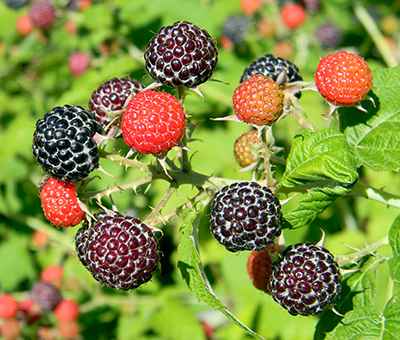Spotted wing Drosophila: A serious pest for the home gardener
This invasive fly, spotted wing Drosophila, can infest and destroy fruits of many plants in home gardens and landscapes.

Since the spotted wing Drosophila (SWD), Drosophila suzukii, was first found in Michigan in 2010, it has become a serious pest of commercially-grown raspberries, blueberries, cherries and other fruit crops, resulting in the loss of well over 25 million dollars. This insect can also be a troublesome pest in home fruit plantings, especially for people who wish to keep pesticide use to minimal levels.
The adult SWD is a small fly, 2-3 millimeters long; the body is usually colored in shades of brown, and its large, compound eyes are red. Adult females can insert eggs through the skin of healthy, intact fruits.
The next stage of SWD is a legless, elongated maggot that feeds internally on the flesh of fruits, causing it to rapidly decay and lose fruit quality. More information about identifying SWD and the damage it makes can be found in Michigan State University Extension’s two-page publication, “Spotted Wing Drosophila Management in Home Fruit Plantings.”

Spotted wing Drosophila are small fruit flies, 2-3 millimeters long. Photo by MSU AgBioResearch.
SWD populations are low in spring but climb rapidly in summer and fall. For this reason, SWD problems tend to be worse on fruits that ripen later in the growing season. For example, summer-bearing raspberries suffer much less damage than fall-bearing raspberries.
The adults and maggots appear similar to a native insect often called the common fruit fly or the vinegar fly, which is technically named Drosophila melanogaster. The common fruit fly is only a nuisance, as it typically does not infest and destroy healthy fruits; it is primarily attracted to over-ripe fruit or fruit damaged by some other pest or during handling. The adult female of the common fruit fly is not able to insert eggs through the skin of intact fruits.
When SWD was first detected in the United States in 2008, it was only known to infest a small number of fruit crops including brambles, such as raspberries and blackberries; sweet and tart cherries; and pears. Since that time, many more host plants have been discovered, and the current tally is over 60 plant species from 24 different plant families. Many of the known hosts are common in home gardens and landscapes. Some are surprising, such as asparagus and burning bush, where SWD can infest the tiny berries the plants produce in summer.
SWD is difficult to control in the yard and garden. It has a high reproductive rate, a short generation time and is not easily detected; people usually find out they have it way too late to take effective actions against it. Good management of SWD problems requires aggressive, pro-active strategies, attention to detail and perseverance. SWD may become the deciding factor for whether or not you continue to grow fruiting trees and shrubs in the home garden.
SWD management for the gardener
- Select species or varieties that ripen in spring to early summer, before SWD populations build up.
- Choose a planting location and design that will allow for efficient maintenance, spraying and harvest. SWD will be very hard to manage if you cannot visit the site frequently. Plants need to be spaced and maintained to allow for good penetration of sprays into the canopy. The fruiting zone of plants needs to be readily accessible to assure clean harvests.
- Carefully consider what other fruiting plants you have on your property and their relative susceptibility to SWD. If possible, remove alternate host plants or take actions to protect them from infestation, too. It may be necessary to seek the cooperation of your neighbors in this process, as adults of SWD can easily fly from one property to another.
- Use traps to detect the activity of adult SWD and identify when to make pesticide applications. See “Spotted Wing Drosophila Management in Home Fruit Plantings” for information about trapping and pesticide options.

Example of a trap used to attract and capture spotted wing Drosophila adults. Photo by Rufus Isaacs, MSU.
- Select and apply pesticides carefully. Check product labels to be sure they are registered for use on your crops, the allowable rates and frequency of use, and for the pre-harvest interval (PHI), which is the days or hours you must wait after a spray before eating the fruit. Sprays need to be applied thoroughly, making sure the product is well distributed in the plant canopy.
- Consider using exclusion netting. If convenient to use in your planting, netting with 1-millimeter (0.03125 inch) mesh can be employed to help protect fruits from SWD. To be effective, the netting must completely cover the plants and be sealed to the surface of the ground. Since the netting would have to be lifted or removed for each harvest, some spraying for SWD might still be necessary.
- Prompt and clean harvest of ripe fruits is essential. Harvest a few fruits very frequently (daily if possible, but always waiting for pesticide PHIs to expire) rather than wait for many fruits to be ripe at once. Undesirable fruits (small, disfigured or injured, etc.) should not be left on the plants or dropped to the ground, as these can be readily infested by SWD and lead to a serious population increase. Culled fruit should be destroyed in a manner that prohibits SWD from infesting it. Seal culled fruit tightly in a plastic bag and throw it in the trash. Do not bury or compost fruit.
- When you finish harvesting fruit for the season, SWD will continue to infest any additional fruit that ripens. This may lead to a high pest population that could invade later crops or provide for a greater over-wintering SWD population that may trouble your crops in the following year.
Download tip sheet version of this article: Spotted wing Drosophila: A serious pest for the home gardener
SWD host plant list

- Adoxaceae: viburnum, blue elderberry, black elderberry, Rocky Mountain elderberry
- Annonaceae: pawpaw
- Aquifoliaceae: catberry
- Araliaceae: devil’s walkingstick
- Berberidaceae: mayaple, hollyleaved barberry
- Buxaceae: sweet box
- Caprifoliaceae: Japanese honeysuckle, Morrow’s honeysuckle, Bell’s blue honeysuckle, tartartian honeysuckle, common snowberry
- Celastraceae: burning bush
- Cornaceae: kousa dogwood, silky dogwood, gray dogwood, stiff dogwood, red osier dogwood
- Cucurbitaceae: cantaloupe, muskmelon
- Ebenaceae: common persimmon
- Elaeagnaceae: autumn olive
- Ericaceae: black huckleberry, blue huckleberry, highbush blueberry, Blue Ridge blueberry
- Grossulariaceae: golden currant, northern black currant
- Lauraceae: spicebush
- Liliaceae: garden asparagus
- Moraceae: edible fig, Illinois ever bearing mulberry, black mulberry, red mulberry
- Phytolaccaceae: American pokeweed
- Ranunculaceae: red baneberry
- Rhamnaceae: glossy buckthorn, common buckthorn, cascara buckthorn
- Rosaceae: purple chokeberry, beach plum, wild black cherry, chokecherry, cultivated sweet and tart cherries, peaches, Alleghany blackberry, Himalaya blackberry, northern dewberry, bristly dewberry, black raspberry, red raspberry, purple flowering raspberry, wine raspberry, salmonberry, milkflower cotoneaster, cherry laurel, Portugal laurel, saskatoon berry, strawberry
- Rutaceae: orange jasmine
- Solanaceae: tomatoes, climbing nightshade, bittersweet nightshade
- Taxaceae: Japanese yew
- Vitaceae: amur peppervine, fox grape, riverbank grape, some varieties of wine grapes
Host plant listings obtained from:
- Spotted wing drosophila (SWD)- crops of concern and wild hosts by Cornell University
- Noncrop host plants of spotted wing drosophila in North America by Oregon State University Extension Service
- Wild hosts of spotted wing drosophila by Ontario Ministry of Agriculture, Food and Rural Affairs
- Spotted wing drosophila by Pennsylvania State University Extension
Download tip sheet version of the SWD host plant list: Spotted wing Drosophila host plant list



 Print
Print Email
Email




